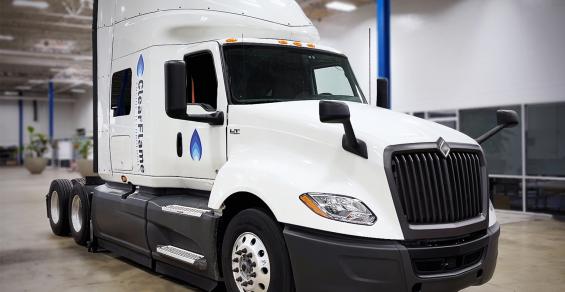The ClearFlame ethanol-powered big rig is ready to roll for on-road testing. More opportunities are available.
Talk with any corn grower who follows the ethanol market and they can tell you about ClearFlame. The startup, created by two Stanford University grads who did preliminary work during their graduate school time, have come up with a way to take a conventional diesel engine and burn 100% ethanol. But all their work has been on the dynamometer — or test bed — until now.
Last week, the startup announced it was moving to the next stage — inserting the modified engine into a semitractor. For a startup to move from lab to field is a big step.
“It felt amazing,” says Julie Blumreiter, co-founder and chief technology officer, ClearFlame Engine Technologies. “I mean it was so exciting to see it in that kind of package. It’s something we’ve been saying for a long time: If it works on the [dynamometer], it will work in a truck.”
It’s a proof point for ClearFlame, showing the startup’s team has the ability to execute on something and take it to the next level.
The engine is a Cummins X15 15-liter, 500-hp engine commonly used for long-haul trucking and off-highway applications. And in this configuration, the machine is converted to run on renewable E98 ethanol.
Prepping to roll
When Farm Progress talked with Blumreiter and B.J. Johnson, CEO and cofounder of ClearFlame, the engine had just been installed in the International rig. Blumreiter explains that there are some issues that need to be worked out before the rig can hit the open road for real-world testing.
“Since we’re using our own controller, there are things about the transmission and shift points that we just need to dial in the same way,” she explains. The electronic mating of engine and drivetrain is great for fuel economy and power management; tweaking the ClearFlame controller to make the connection is well underway.
Related: Startup rethinks diesel power
A potential benefit of this technology is to end the use of pollution control technology, including diesel particulate filters and potentially selective catalytic reduction. Johnson explains that in the first fleet, that emissions tech will stay on the rig. “Our first product has so much value in the ability to cost effectively decarbonize existing engines, it has turned the elimination of SCR into a nice-to-have, not a must-have,” Johnson explains. “And while we want to get to the nice-to-have eventually, there’s enough demand for the ‘must-have’ that we don’t want to wait before we put something on the market.”
Another part of this system is that it is technically fuel-agnostic. Blumreiter explains that the foundational science behind ClearFlame and its technology is finding a way to make any fuel act like diesel fuel — whatever that fuel’s base ignition characteristics are. “So, when we talk about being fuel-agnostic, and they are using ethanol right now, what we did is, we looked at the fuels we could use that are clean-burning, what is abundant, what is low-cost,” she says. “And being fuel-agnostic allows us to select fuels based on those criteria. So, it’s really unlocking for any fuel — and the fuel we’re focused on right now are the alcohols.”
Adds Johnson: “It’s an important part of this story. You don’t need the mandate for any particular fuel choice. This is the fuel that you would choose purely on its economic and environmental benefits, and I think that’s an important message — that ClearFlame is agnostic, and we chose ethanol. We didn’t have to have it, but it was the best option.”
Getting on the road
The truck will be ready to roll once the final control issues are complete. Blumreiter is working to get her commercial driver’s license, while Johnson says he’s superstitious about being near the truck.
“I am quite irrationally superstitious, and I’m not sure it’s a good idea for me to ever even touch this thing,” he laughs.
Blumreiter adds: “I was, like, pushing the engineer out of the seat to drive it the first day.”
Johnson notes that Blumreiter “is still the rational engineer. I’ve become a business person, and I’m subject to all these superstitious whims.”
While you might not see Johnson behind the wheel at all, Blumreiter wants to get the truck on the road. She won’t be the test driver, but she will do some seat time.
This is a machine that has captured the attention of ethanol makers, the National Corn Growers Association and John Deere. The latter participated in the recent $17 million Series A funding ClearFlame received. And the next engine in the works for a conversion is the John Deere 9-liter, which is a popular model for both ag and construction.
Johnson says there’s no information on what application Deere has in mind, for now. Farm Progress will keep following ClearFlame’s progress.
Learn more at clearflame.com.




